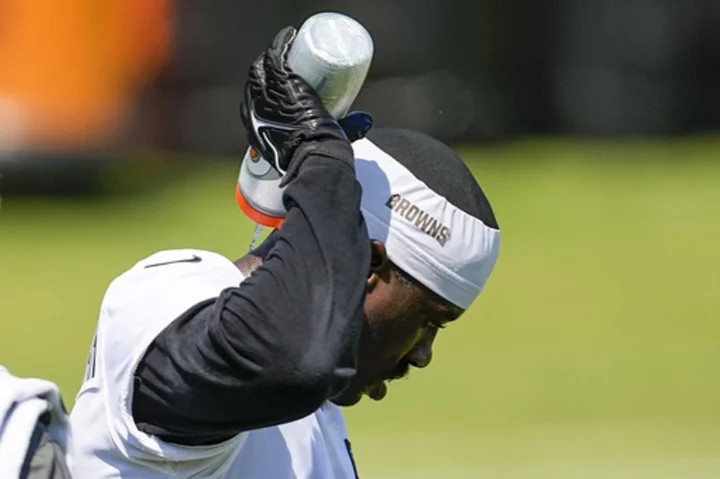HENDERSON, Nev. (AP) — The sight of wide receivers Keith Kirkwood and Shaq Davis leaving practice early this week because of heat-related symptoms was nothing new for the New Orleans Saints, with the hot and humid Louisiana weather a test for even the best-conditioned athletes.
The unrelenting, record-breaking heat across the nation this year has made the opening of training camps even more challenging than usual, however, not only for the Saints but teams throughout the NFL.
Scientists have already calculated this will be the hottest July on record, with the Southwest and parts of the South especially hit hard. Most of the Midwest and East also have been affected. That means NFL teams have to be even more mindful than usual about keeping players safe while also getting as much work done as possible before the season begins in September.
Safety has been a centerpiece of the preseason since Minnesota offensive tackle Korey Stringer died on Aug. 1, 2001, after slipping and falling the previous day after a Vikings training camp practice. NFL teams at the time didn't have medical training for exertional heat stroke.
Some teams are taking extra precautions this year, including more water breaks and early practice times.
“I don’t know all the science and all that stuff, but I do my best to understand it," Saints quarterback Derek Carr said. "I’ve seen growth ... from when I first came in the league to what we talk about now. It’s definitely a difference on the things we talk about, the way we practice, how long we do something … how much time you’re actually accumulating outside during the week.”
Carr is in his first season in New Orleans, so he's acclimating to the wet, muggy conditions. He spent the previous three seasons with the Raiders in Las Vegas, where the air is dry but temperatures are considerably higher.
“It just feels like your skin is going to fall off,” Carr said of playing in Las Vegas. “It feels like it’s boiling.”
For their part, the Raiders have begun practicing at 8:30 a.m. to avoid the hottest parts of the day but still must contend with temperatures in the triple digits by the time they walk off the field.
The Raiders have an indoor facility but usually practice outside because it's more spacious and the fields are grass rather than turf. Cool boxes are set up just off the 50-yard line near one of the three practice fields that players use, and coach Josh McDaniels said the team met before camp opened to discuss coping with the conditions.
McDaniels said the key was listening to medical professionals.
“They have a very scientific way to measure (weather and safety conditions) that I’m not really qualified to speak intelligently about," McDaniels said. "But I understand when they tell me that we’ve entered into a zone where it’s dangerous to be out there with helmets, pads, etc., then we’ll do the right thing.”
Two warm weather teams avoid practicing in the heat altogether. The Arizona Cardinals use their indoor facility and the Dallas Cowboys hold camp in moderate Southern California.
Other teams, particularly those in the hottest parts of the country, have to adapt to the weather.
“The health and safety of the players is the most important thing for our team and our organization,” Houston Texans general manager Nick Caserio said. “Whatever we can do to help the players in that respect, that’s the most important thing. It’s going to be hot wherever you go, but you want to be smart.”
Caserio said some players wear hoodies and sweatpants so they can sweat “and let that heat leave your body. If you don't, you can potentially be putting yourself at risk.”
For a second consecutive camp, coach Ron Rivera scheduled Washington Commanders practices for 9 a.m. as one way to try to beat the heat. A stretch of record temperatures last year contributed to several soft-tissue injuries, so the staff is taking further steps this time around, from more water breaks to a cooling tent that players are sent to if they begin to feel the effects.
“We’re constantly trying to get them to hydrate and get them focusing on hydrating prior to practice and post-practice,” Rivera said.
Other coaches take a different approach, knowing many early season games are played when temperatures are at their highest.
“You look at our first game against Pittsburgh last year here at home," Cincinnati Bengals coach Zac Taylor said. "On offense, there were over 100 snaps and you played an overtime game. ... We want our guys to be ready for that, and we feel like we will.”
Few players go as hard as Raiders defensive end Maxx Crosby, who spent part of the offseason sparring with a UFC fighter. He said part of his preparation for the heat is building up the body before camp begins.
“You can’t just train in the air conditioning and then go out and feel like you’re going to be fine in the heat,” Crosby said. “So we’ve done back and forth. I’ve trained inside, I’ve trained outside this offseason, just doing a bunch of different things to get ready for training camp.”
Much is at stake in camp, so players want to be on the field far more than in the cooling box or on the trainer's table. They're fighting for starting jobs and roster spots, and those players know that coaches and general managers are watching to see who best battles through adversity.
“The job’s got to get done," Miami Dolphins offensive tackle Kendall Lamm said, “with or without the heat.”
___
AP Sports Writers Brett Martel in Metairie, Louisiana; Kristie Rieken in Houston; Mitch Stacy in Cincinnati; Alanis Thames in Miami Gardens, Florida; and Stephen Whyno in Ashburn, Virginia, contributed to this report.
___
AP NFL: https://apnews.com/hub/nfl and https://twitter.com/AP_NFL

